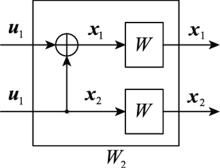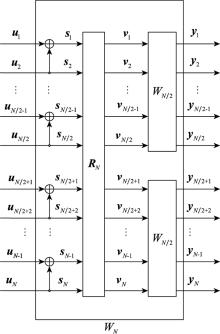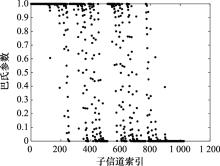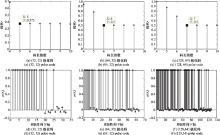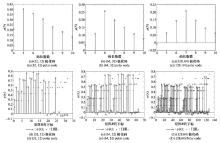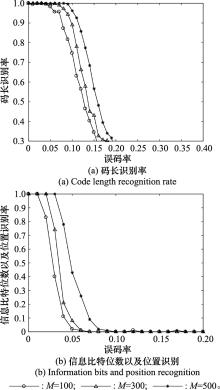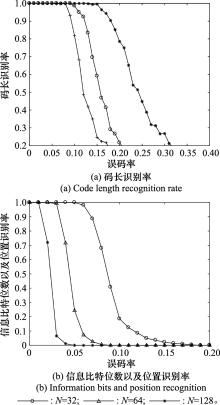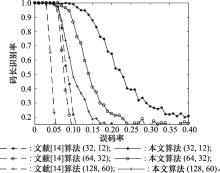| 1 |
ARIKAN E, TELATAR E. On the rate of channel polarization[C]//Proc. of the IEEE International Symposium on Information Theory, 2009: 1493-1495.
|
| 2 |
GAMAGE H, RAJATHEVA N, LATVA-AHO M. Channel coding for enhanced mobile broadband communication in 5G systems[C]//Proc. of the European Conference on Networks and Communications, 2017.
|
| 3 |
刘荣科, 孙贺, 冯宝平, 等. 极化码研究综述[J]. 遥测遥控, 2020, 41 (4): 2- 17.
|
|
LIU R K , SUN H , FENG B P , et al. A survey of polar code research[J]. Journal of Telemetry, Tracking and Command, 2020, 41 (4): 2- 17.
|
| 4 |
PLANQUETTE G. Identification of binary code streams[D]. Rennes: University of Rennes Ⅰ, 1996.
|
| 5 |
张天骐, 易琛, 张刚, 等. 基于高斯列消元法的线性分组码参数盲识别[J]. 系统工程与电子技术, 2013, 35 (7): 1514- 1519.
|
|
ZHANG T Q , YI C , ZHANG G , et al. Blind identification of parameters of linear block codes based on columns Gaussian elimination[J]. Systems Engineering and Electronics, 2013, 35 (7): 1514- 1519.
|
| 6 |
张天骐, 王俊霞, 江晓磊, 等. 基于校验矩阵匹配的循环码参数盲识别算法[J]. 电子与信息学报, 2017, 39 (4): 901- 907.
|
|
ZHANG T Q , WANG J X , JIANG X L , et al. Blind recognition of cyclic code based on check matrix match algorithm[J]. Journal of Electronics & Information Technology, 2017, 39 (4): 901- 907.
|
| 7 |
吴昭军, 张立民, 钟兆根, 等. 一种软判决下的RS码识别算法[J]. 电子与信息学报, 2020, 42 (9): 2150- 2157.
|
|
WU Z J , ZHANG L M , ZHONG Z G , et al. Blind recognition of RS codes based on soft decision[J]. Journal of Electronics & Information Technology, 2020, 42 (9): 2150- 2157.
|
| 8 |
张立民, 吴昭军, 钟兆根. 一种基于遗传算法的RSC码盲识别方法[J]. 航空学报, 2017, 38 (11): 277- 286.
|
|
ZHANG L M , WU Z J , ZHONG Z G . A blind recognition method of RSC code based on genetic algorithm[J]. Acta Aeronautica et Astronautica Sinica, 2017, 38 (11): 277- 286.
|
| 9 |
吴昭军, 张立民, 钟兆根, 等. 低信噪比下RSC码快速迭代寻优识别算法[J]. 电子学报, 2019, 47 (7): 1566- 1574.
doi: 10.3969/j.issn.0372-2112.2019.07.023
|
|
WU Z J , ZHANG L M , ZHONG Z G , et al. Fast iterative recogniton of RSC encoder at low SNR[J]. Acta Electronica Sinica, 2019, 47 (7): 1566- 1574.
doi: 10.3969/j.issn.0372-2112.2019.07.023
|
| 10 |
于沛东, 彭华, 巩克现, 等. 基于寻找小重量码字算法的LDPC码开集识别[J]. 通信学报, 2017, 38 (6): 108- 117.
|
|
YU P D , PENG H , GONG K X , et al. LDPC code reconstruction based on algorithm of finding low weight code-words[J]. Journal on Communications, 2017, 38 (6): 108- 117.
|
| 11 |
陈泽亮, 彭华, 巩克现, 等. 误码条件下LDPC码参数的盲估计[J]. 电子学报, 2018, 46 (3): 652- 658.
doi: 10.3969/j.issn.0372-2112.2018.03.021
|
|
CHEN Z L , PENG H , GONG K X , et al. A method for blind recogniton of LDPC codes in a noisy environment[J]. Acta Electronica Sinica, 2018, 46 (3): 652- 658.
doi: 10.3969/j.issn.0372-2112.2018.03.021
|
| 12 |
刘骏, 李静, 彭华. DVB_RCS协议中双二进制卷积Turbo码识别[J]. 信息工程大学学报, 2015, 16 (5): 574- 578.
doi: 10.3969/j.issn.1671-0673.2015.05.011
|
|
LIU J , LI J , PENG H . Identification of double binary convolutional Turbo codes in DVB_RSC protocol[J]. Journal of Information Engineering University, 2015, 16 (5): 574- 578.
doi: 10.3969/j.issn.1671-0673.2015.05.011
|
| 13 |
钟兆根, 吴昭军, 刘杰, 等. 高误码率下归零Turbo码帧结构识别[J]. 电子学报, 2019, 47 (10): 2089- 2097.
doi: 10.3969/j.issn.0372-2112.2019.10.010
|
|
ZHONG Z G , WU Z J , LIU J , et al. Blind identification of frame structure of Turbo codes on trellis termination at high bit error[J]. Acta Electronica Sinica, 2019, 47 (10): 2089- 2097.
doi: 10.3969/j.issn.0372-2112.2019.10.010
|
| 14 |
张天骐, 胡延平, 冯嘉欣, 等. 基于零空间矩阵匹配的极化码参数盲识别算法[J]. 电子与信息学报, 2020, 42 (12): 2953- 2959.
doi: 10.11999/JEIT190935
|
|
ZHANG T Q , HU Y P , FENG J X , et al. Blind identification algorithm of polarization code parameters based on null space matrix matching[J]. Journal of Electronics & Information Technology, 2020, 42 (12): 2953- 2959.
doi: 10.11999/JEIT190935
|
| 15 |
吴昭军, 钟兆根, 张立民, 等. 基于软判决下的不删余极化码参数识别[J]. 通信学报, 2020, 41 (12): 60- 71.
|
|
WU Z J , ZHONG Z G , ZHANG L M , et al. Recognition of non-drilled polar codes based on soft decision[J]. Journal on Communications, 2020, 41 (12): 60- 71.
|
| 16 |
ARIKAN E. Channel polarization: a method for constructing capacity-achieving codes[C]//Proc. of the IEEE International Symposium on Information Theory, 2008: 1173-1177.
|
| 17 |
ZHANG Q S , LIU A J , PAN X F , et al. CRC code design for list decoding of polar codes[J]. IEEE Communications Letters, 2017, 21 (6): 860- 862.
|
| 18 |
ARIKAN E . Channel polarization: a method for constructing capacity-achieving codes for symmetric binary-Input memoryless channels[J]. IEEE Trans.on Information Theory, 2009, 55 (7): 3051- 3073.
doi: 10.1109/TIT.2009.2021379
|
